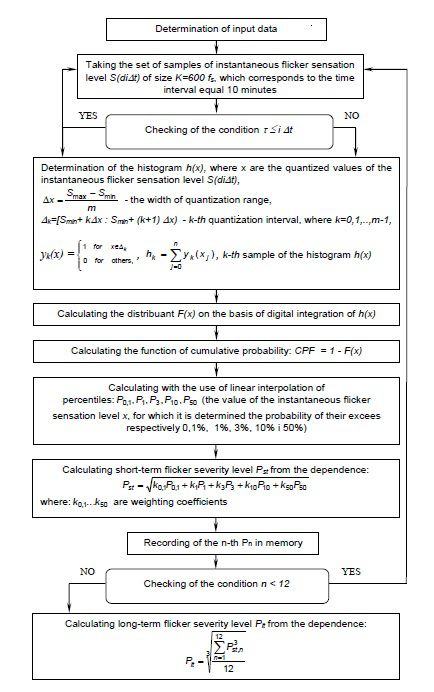The short-term flicker severity level measured in the industrial power system supplying the rolling mill motors

Description
The dataset presents a short-term flicker severity level measured on the bus bars of the main switchgear of the industrial power network for the supply of rolling mills. The data were obtained during an experiment whose purpose was to determine a level of short-term and long-term flicker caused by voltage fluctuations. In the virtual application of flickermeter, a hardware (acquisition of measuring data) and a software (computer data processing and graphical interface) part is distinguished. The attached dataset contains analysis results based on processed data at the output of the software part of the flickermeter.
In the low voltage supply lines, the basic sinusoidal course is accompanied by undesirable courses of different shapes, levels, duration, both determinate (and particularly periodical ones) and random. The most common cause of low-frequency interference (below the basic supply line frequency) is violent loading changes of high power receivers. One of the effects of the occurrence of undesirable low-frequency courses is the flicker phenomenon, being a subjective visual sensation of the human eye to slow changes of light fluctuation and periodic light luminance. So for instance, voltage variations of about 5% within the frequency range from 6 to 8 Hz can cause noticeable flickering. Because of a random character of the flicker phenomenon, two statistical factors Pst and Plt are to be determined. The short-term flicker severity level Pst is determined by means of a cumulative probability function CPF of instantaneous flicker sensation values. This is a curve of orderly probabilities, which does not exceed definite values of the flicker levels in the respective time, for a recording period of the course under investigation equal to 10 minutes. Pst = 1[p.u.] corresponds to the flicker perceptibility threshold, which must not be exceeded in order to avoid the psychic discomfort of the observer.
The virtual application of the flicker severity meter Flickermeter. vi is developed in the LabVIEW programming environment. The following input data are introduced at the input of the virtual instrument, consisting of two sub-programs: one determining the instantaneous flicker sensation level and a statistical analyzer (Fig. 1), in which the flicker severity factors are calculated:
- fs sampling frequency equal to 20 000 S/s,
- Ts time of observation equal to 10 min,
- procedure repeating time,
- m number of quantization levels (classes) equal to 1024.
The short-term flicker severity levels Pst are calculated over a total measurement time of 60 minutes, for 10-minute time windows, shifting in 1-minute steps.
The presented analyzes are made on based data from the dataset [Pałczyńska, B. (2021). A cumulative probability function of instantaneous flicker sensation values measured in the industrial power system supplying the rolling mill motors [Data set]. Gdańsk University of Technology. https://doi.org/10.34808/vkv8-976]

Figure 1. Algorithm of calculating the flicker severity levels Pst and Plt
Dataset file
hexmd5(md5(part1)+md5(part2)+...)-{parts_count} where a single part of the file is 512 MB in size.Example script for calculation:
https://github.com/antespi/s3md5
File details
- License:
-
open in new tab
CC BYAttribution
Details
- Year of publication:
- 2021
- Verification date:
- 2021-06-25
- Creation date:
- 2000
- Dataset language:
- English
- Fields of science:
-
- Automation, electronic and electrical engineering (Engineering and Technology)
- DOI:
- DOI ID 10.34808/zf4h-5w16 open in new tab
- Series:
- Verified by:
- Gdańsk University of Technology
Keywords
- voltage fluctuations
- flickermeter
- switchgear of the industrial power network
- rolling mill
- instantaneous flicker sensation level
- flicker
- cumulative probability function
- short-term flicker severity level
References
- dataset Voltage fluctuations on the main switchgear of the industrial power system supplying the rolling mill motors
- dataset Voltage fluctuations on the main switchgear of the industrial power system supplying the rolling mill motors_part_2
- dataset The instantaneous flicker sensation level measured in the industrial power system supplying the rolling mill motors
- dataset A cumulative probability function of instantaneous flicker sensation values measured in the industrial power system supplying the rolling mill motors
Cite as
Authors
seen 288 times
